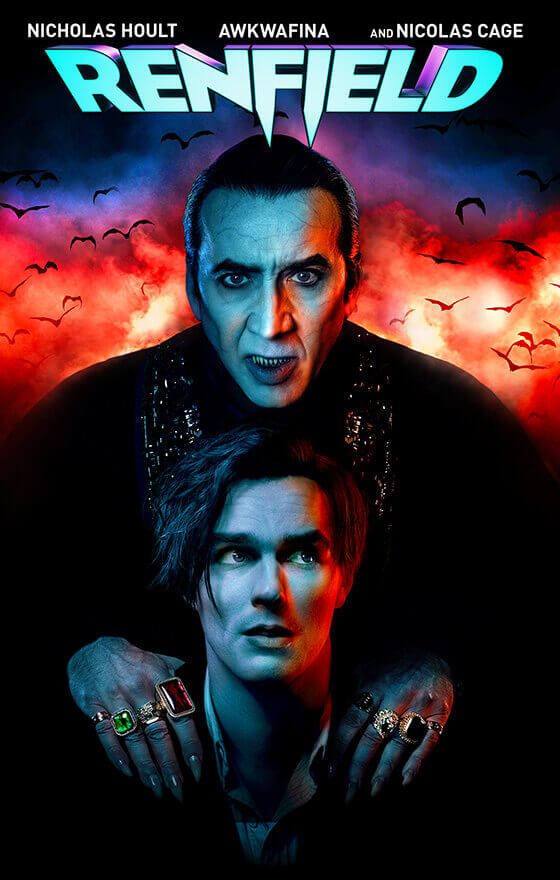‘Renfield’: A Fang-tastic Horror Comedy
A sequel to the 1931 ‘Dracula,’ the film bestowed fans with an in-depth look at Dracula and Renfield’s relationship in the present age
UNIVERSAL STUDIOS
“Renfield” brings the 1931 original “Dracula” to the modern day and tells the Renfield-Dracula relationship through a horror-comedy.
June 9, 2023
Warning: This article includes minor spoilers to “Renfield” and details regarding the film’s plot.
Bram Stoker’s “Dracula” is an undying tale that has captivated audiences for centuries. To this day, fans of horror and gothic fiction alike remain equally passionate about the tale. On April 14, Universal Pictures released “Renfield,” the newest installment in their monster film franchise, which tells the story of Renfield (Nicholas Hoult), Dracula’s (Nicolas Cage) servant and familiar.
Through his duty, Dracula bestowed Renfield with a portion of his powers, which is activated through the consumption of bugs. Renfield is to use his powers to supply Dracula with victims. Following an encounter with the Catholic Church, however, Dracula’s power and strength weaken, forcing the duo to move to New Orleans to recuperate.
Compared to Universal’s early monster films, “Renfield” brings a more playful, colorful and comedic tone to the monster universe.
Overtime, Renfield grows exhausted of Dracula’s abuse, leading him to join a support group for people in abusive relationships. He develops concern regarding the ethics of his work for his master, and begins to target people who have committed injustices, particularly the abusers of his peers at the support group.
Renfield’s ill-hearted victims, however, proved to be unsatisfactory to Dracula. The Count begins requesting Renfield to bring him innocent victims, as their blood provides him with more nutrition. Renfield recognizes his codependency on Dracula and — with the help of his support group — attempts to break the cycle by creating a life for himself. His life of independence is short lived, however, because Dracula’s power continues to reign over him as he encounters The Lobos, a family head of a drug empire.
Compared to Universal’s early monster films, “Renfield” brings a more playful, colorful and comedic tone to the monster universe. It does a fantastic job paying homage to the original Dracula, played by Bela Lugosi in the original “Dracula”.
The opening scenes to “Renfield” consisted of mimicked black and white shots of the 1931 film. Lugosi has gone down in goth and horror history as one of the greatest, even inspiring iconic goth songs such as “Bela Lugosi’s Dead” by Bauhaus. Thus, “Renfield’s” tribute was a natural and excellent choice.
The film overall is incredibly intense in its genre, somehow being able to pull off a mix of horror, comedy, thrill and drama. It contains an excellent balance of theatrical gore and action as well.
Although Renfield and Dracula both die in the 1931 film, this movie plays on the events that would occur if both survived or were resurrected and takes place in the modern age. The film does a great job of providing background information regarding Dracula and Renfield’s relationship, allowing for a wider film audience, including those with no prior knowledge of the story.
Cage’s portrayal of Count Dracula was superb. His ghoulish facial expressions/voice, elegant vampiric wardrobe combined with Cage’s signature over the top performances, proved to be ideal casting. Similarly, Hoult delivered a different, but fantastic, performance as Renfield, drawing on an early 2000’s emo look with an emotionally conflicted character arc.
Regarding the casting decisions, one concern I had prior to watching the film was the choice to feature Awkwafina, who plays a cop named Rebecca Quincy working to take down a local drug empire that killed her father. In previous films, I’ve found that Awkwafina displays very little range in her acting which led to my slight dissatisfaction with her implied on-screen romance with Renfield. Her character, however, did fit into the comedic stance of the film.
The film overall is incredibly intense in its genre, somehow being able to pull off a mix of horror, comedy, thrill and drama. It contains an excellent balance of theatrical gore and action as well. In terms of “Renfield’s” plot, my only complaint would be the unexplained ending regarding the corrupt police department and the incarceration of The Lobos. This is easy to skim by, however, given the fantastic nature of the rest of the film.
The plot was well paced and engaging, with Renfield narrating the story. Written by Ryan Ridley, former writer for the adult animated science fiction sitcom “Rick and Morty,” the comedic screenwriting was actually intelligent and funny, focusing on the toxic relationship Renfield has with the narcissistic Dracula. I worried that the comedy would be of similar nature to the corny one-liners in Marvel films, but the humor fit in perfectly and did not take away from drama.
I particularly love the use of vibrant lights and colors used in “Renfield,” which created beautiful cinematography. Additionally, the New Orleans setting provided the perfect spooky atmosphere for the film.
“Renfield” included some excellent songs with Radiohead’s “Creep” in its final trailer and a fitting selection of My Chemical Romance’s “Na Na Na (Na Na Na Na Na Na Na Na Na)” within the movie itself. The score, crafted by Marco Beltrami, properly encapsulates Dracula and Renfield’s eerie beginnings and an action packed plot.
Overall, “Renfield” was an incredibly entertaining watch. I am obsessed with Cage and Hoult’s performances, the comedic plot, and the fantastic soundtrack and score. It served as a perfect “feel good” horror comedy, with it being the most fun I have ever had watching a film in theaters.
“Renfield” is no longer showing in theaters and is set to stream exclusively on Peacock on June 9.












